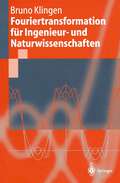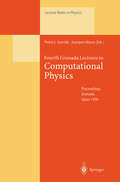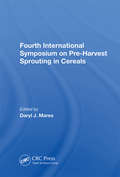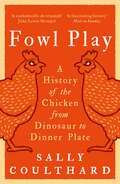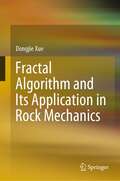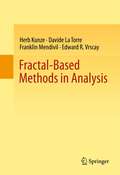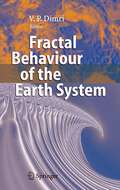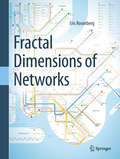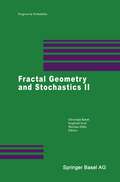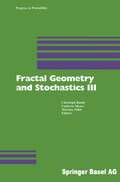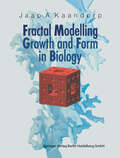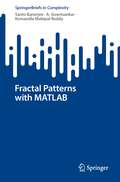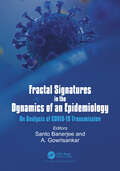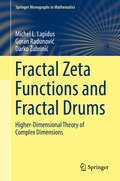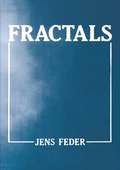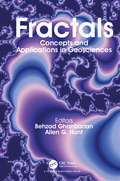- Table View
- List View
Fouriertransformation für Ingenieur- und Naturwissenschaften (Springer-Lehrbuch)
by Bruno KlingenDieses Lehrbuch wendet sich an Studenten der Ingenieurfächer und der Naturwissenschaften. Durch seinen systematischen und didaktischen Aufbau vermeidet es ungenaue Formulierungen und legt so die Grundlage für das Verständnis auch neuerer Methoden. Indem die klassische und die Funktionalanalysis auf der Basis des Fourieroperators zusammengeführt werden, vermittelt es ein fundiertes und verantwortbares Umgehen mit der Fouriertransformation. Gleichzeitig bietet dieses Konzept die Möglichkeit, auch die Fourierreihen, die diskrete Fouriertransformation und die Behandlung der diskreten Filter in einem einheitlichen Zusammenhang darzustellen. Das Buch enthält zahlreiche gelöste Übungsaufgaben. NEU ! Online-Ergänzungen zum Buch im Internet: - zum Kennenlernen und Vergleichen der mathematischen Programmiersysteme Mathematica, Matlab, Maple - zur Vertiefung des Buchinhaltes (unter "Extras im Web")
Fourteen Wolves: A Rewilding Story
by Catherine BarrIn fairy tales, the wolf's cry makes people shudder. They've been hunted, captured. But the wolf carries a wild magic - a magic that once restored a barren land. When wolves disappeared from Yellowstone Park in the 1930s, the ecosystem started to collapse. Enormous herds of elk swarmed the plains, bears starved, rabbit families shrunk and birds flew away to new homes. Plants vanished, trees withered and rivers meandered. Until in 1995, wolves returned to the park and everything began to change for the better. This is the story of their homecoming. With atmospheric storytelling from Catherine Barr and breathtakingly beautiful artwork by Jenni Desmond, this inspiring true story shows that every species plays an important part in protecting our planet.
Fourth Granada Lectures in Computational Physics: Proceedings of the 4th Granada Seminar on Computational Physics Held at Granada, Spain, 9–14 September 1996 (Lecture Notes in Physics #493)
by Pedro L. Garrido Joaquin MarroThe methods developed to deal with the computational aspects of physi cal problems are useful in an increasing number of situations, from chem istry, biology and geology to engineering, communications and economics. In fact, computational physics has evolved into a trans-disciplinary field now concerned with the creative use of computers in scientific research. More over, computational methods often help students to develop a deeper under standing of key concepts, and enhance their problem-solving abilities. There fore, computational physics is recognized as having an important educational value, and educators face the task of outlining appropriate curricula to take advantage of these unique features. This is an important motivation for the publication of the contents of the Seminar on Computational Physics which is held in Granada every two years. The seminar aims at bringing together small groups of students and active researchers on different aspects of computational physics. It is part of the doctoral programme of the University of Granada. The proceedings of the previous editions were published as II Granada Lectures in Computational Physics (World Scientific, Singapore 1993) and Third Granada Lectures in Computational Physics (Lecture Notes in Physics, vol. 448, Springer, Berlin 1995) by the same editors. The present book contains the invited lecture notes and a very brief account of contributions by participants at the 4th Granada Seminar on Computational Physics (Granada, Spain, 9-14 September 1996).
The Fourth Industrial Revolution and Its Impact on Ethics: Solving the Challenges of the Agenda 2030 (Sustainable Finance)
by Karen Wendt Katharina MillerThis book tackles the ethical problems of the “Fourth Industrial Revolution” (4IR) and offers readers an overview of the ethical challenges connected to Artificial Intelligence (AI), encryption and the finance industry. It specifically focuses on the situation of females in these industries, from women lawyers, judges, attorneys-at-law, investors and bankers, to portfolio managers, solicitors and civil servants. As the 4IR is more than “just” a technology-driven transformation, this book is a call to policymakers and business leaders to harness new technologies in order to create a more inclusive, human-centered future. It offers many practical cases of proactive change agents, and offers solutions to the ethical challenges in connection with implementing revolutionary disruptive products that often eliminate the intermediary. In addition, the book addresses sustainable finance in startups. In this context, education, training, agility and life-long learning in financial literacy are some of the key solutions highlighted here. The respective contributors supply a diverse range of perspectives, so as to promote a multi-stakeholder approach.
Fourth International Symposium On Pre-harvest Sprouting In Cereals
by Daryl MaresA major constraint on the production of high-quality grain around the world, pre-harvest sprouting in cereal crops causes substantial economic losses to producers and disrupts the processing, distribution, marketing, and storage of grain products. The solution to this problem must include a better understanding of the phenomenon, the development of
Fourth International Symposium On Pre-harvest Sprouting In Cereals
by Daryl MaresA major constraint on the production of high-quality grain around the world, pre-harvest sprouting in cereal crops causes substantial economic losses to producers and disrupts the processing, distribution, marketing, and storage of grain products. The solution to this problem must include a better understanding of the phenomenon, the development of
Fowl Play: A History of the Chicken from Dinosaur to Dinner Plate
by Sally CoulthardFrom dinosaur to dinner plate, Sally Coulthard tells the fascinating – and sometimes shocking – story of the domestic chicken.The chicken can fly only a few metres but – somehow – this unlikely evolutionary descendant of Tyrannosaurus Rex has conquered the world. Earth is now home to more than twenty billion chickens, at least ten times more than any other bird. For every human on the planet, there are three chickens.In Fowl Play, Sally Coulthard charts the chicken's fascinating journey from dinosaur to domestication to exploitation, exploring every aspect of the history of Gallus gallus domesticus: its importance to the ancient Egyptians, Greeks and Romans as food source and fighting bird; its symbolic roles in religion and folklore and metaphorical function in the language we use; its homely place as egg-providing companion on farms, smallholdings and in suburban back gardens; and its darker modern-day fate as battery bird raised to satisfy society's unquenchable addiction to wings and nuggets.Of all animals, chickens perhaps best represent the contradictory way we humans treat other species; both beloved pet and cheap commodity, symbol of a sustainable good life and brutalised object of factory farming. The chicken is also a bird we feel deeply familiar with and yet know very little about. As informative as it is entertaining, Fowl Play tells a remarkable tale of evolutionary change, epic global travel and ruthless exploitation – as well as of companionship, ingenuity and the folly of human nature.
Fracking - Die neue Produktionsgeografie
by Christiane Habrich-Böcker Beate Charlotte Kirchner Peter WeißenbergDie Energieversorgung der Welt steht vor einer radikalen Wende: Mit Fracking erschließt eine neue Techniken bislang unerreichbare Öl- und Gasquellen in der Tiefe. Das verändert die Spielregeln im globalen Energiemarkt. Durch die Ausbeutung dieser sogenannten unkonventionellen Lagerstätten können einige Staaten, die bislang von Öl- und Gas-Importen abhängig sind, zu Exporteuren aufsteigen. Die Preise für Energie werden gerade in diesen Regionen enorm sinken. Unternehmen investieren Milliarden in Fracking und die LNG-Technologie zur Erdgasverflüssigung – und verändern damit das Gefüge der Weltwirtschaft. Für energieintensive Industrien wie Stahl- und Aluminiumhütten, Automobilfertigung oder Maschinenbau werden etwa Verlagerungen in der Produktion nötig, um die Wettbewerbsfähigkeit zu halten. Doch die Fracking-Technologie ist heftig umstritten. In diesem Buch stellen Experten den neuesten Stand der Diskussion, Chancen und Risiken des Fracking-Booms vor. Entscheider aus Politik, Wirtschaft und Gesellschaft können sich so ein unvoreingenommenes Bild machen, um in einer aufgeheizten Debatte kompetent teilnehmen zu können.
Fracking - Die neue Produktionsgeografie
by Christiane Habrich-Böcker Beate Charlotte Kirchner Peter WeißenbergDie Energieversorgung der Welt steht vor einer radikalen Wende: Mit Fracking erschließt eine neue Technik bislang unerreichbare Öl- und Gasquellen in der Tiefe. Das verändert die Spielregeln im globalen Energiemarkt. Durch die Ausbeutung dieser sogenannten unkonventionellen Lagerstätten können einige Staaten, die bislang von Öl- und Gas-Importen abhängig sind, zu Exporteuren aufsteigen. Die Preise für Energie werden gerade in diesen Regionen enorm sinken. Unternehmen investieren Milliarden in Fracking und die LNG-Technologie zur Erdgasverflüssigung – und verändern damit das Gefüge der Weltwirtschaft. Für energieintensive Industrien wie Stahl- und Aluminiumhütten, Automobilfertigung oder Maschinenbau werden etwa Verlagerungen in der Produktion nötig, um die Wettbewerbsfähigkeit zu halten. Doch die Fracking-Technologie ist heftig umstritten. In diesem Buch stellen Experten den neuesten Stand der Diskussion, Chancen und Risiken des Fracking-Booms vor. Entscheider aus Politik, Wirtschaft und Gesellschaft können sich so ein unvoreingenommenes Bild machen, um an einer aufgeheizten Debatte kompetent teilnehmen zu können. Die 2. Auflage wurde durchgesehen, aktualisiert und um aktuelle Technologiefakten, Statements mit dem aktuellen Stand der Gesetzgebung sowie Prognosen ergänzt.
Fractal Algorithm and Its Application in Rock Mechanics
by Dongjie XueThis book focuses on learning and adapting nonlinear geometry tool in rock engineering through fractal theories, hypotheses, algorithm, practical understandings, and case studies. Understanding self-similarity and self-affinity is a prerequisite to the fractal model in rock mechanics. The book aims to provide a guide for the readers seeking to understand and build nonlinear model by fractal algorithm. The book is motivated by recent rapid advances in rock engineering in China including application of fractal theory, in addition to percolation theory. It is an essential reference to the most promising innovative rock engineering. Chapters are carefully developed to cover (1) new fractal algorithms (2) five engineering cases. This authored book addresses the issue with a holistic and systematic approach that utilizes fractal theory to nonlinear behavior in rock engineering. The book is written for researchers interested in rock and geological engineering as well as organizations engaged in underground energy practices.
Fractal-Based Methods in Analysis
by Herb Kunze Davide La Torre Franklin Mendivil Edward R. VrscayThe idea of modeling the behaviour of phenomena at multiple scales has become a useful tool in both pure and applied mathematics. Fractal-based techniques lie at the heart of this area, as fractals are inherently multiscale objects; they very often describe nonlinear phenomena better than traditional mathematical models. In many cases they have been used for solving inverse problems arising in models described by systems of differential equations and dynamical systems. "Fractal-Based Methods in Analysis" draws together, for the first time in book form, methods and results from almost twenty years of research in this topic, including new viewpoints and results in many of the chapters. For each topic the theoretical framework is carefully explained using examples and applications. The second chapter on basic iterated function systems theory is designed to be used as the basis for a course and includes many exercises. This chapter, along with the three background appendices on topological and metric spaces, measure theory, and basic results from set-valued analysis, make the book suitable for self-study or as a source book for a graduate course. The other chapters illustrate many extensions and applications of fractal-based methods to different areas. This book is intended for graduate students and researchers in applied mathematics, engineering and social sciences. Herb Kunze is a professor of mathematics at the University of Guelph in Ontario. Davide La Torre is an associate professor of mathematics in the Department of Economics, Management and Quantitative Methods of the University of Milan. Franklin Mendivil is a professor of mathematics at Acadia University in Nova Scotia. Edward Vrscay is a professor in the department of Applied Mathematics at the University of Waterloo in Ontario. The major focus of their research is on fractals and the applications of fractals.
Fractal Behaviour of the Earth System
by V. P. DimriIt is with pleasure that I write the foreword to this excellent book. A wide range of observations in geology and solid-earth geophysics can be - plained in terms of fractal distributions. In this volume a collection of - pers considers the fractal behavior of the Earth's continental crust. The book begins with an excellent introductory chapter by the editor Dr. V.P. Dimri. Surface gravity anomalies are known to exhibit power-law spectral behavior under a wide range of conditions and scales. This is self-affine fractal behavior. Explanations of this behavior remain controversial. In chapter 2 V.P. Dimri and R.P. Srivastava model this behavior using Voronoi tessellations. Another approach to understanding the structure of the continental crust is to use electromagnetic induction experiments. Again the results often exhibit power law spectral behavior. In chapter 3 K. Bahr uses a fractal based random resister network model to explain the observations. Other examples of power-law spectral observations come from a wide range of well logs using various logging tools. In chapter 4 M. Fedi, D. Fiore, and M. La Manna utilize multifractal models to explain the behavior of well logs from the main KTB borehole in Germany. In chapter 5 V.V. Surkov and H. Tanaka model the electrokinetic currents that may be as- ciated with seismic electric signals using a fractal porous media. In chapter 6 M. Pervukhina, Y. Kuwahara, and H. Ito use fractal n- works to correlate the elastic and electrical properties of porous media.
Fractal Dimensions of Networks (Springerbriefs In Computer Science Ser.)
by Eric RosenbergCurrent interest in fractal dimensions of networks is the result of more than a century of previous research on dimensions. Fractal Dimensions of Networks ties the theory and methods for computing fractal dimensions of networks to the “classic” theory of dimensions of geometric objects.The goal of the book is to provide a unified treatment of fractal dimensions of sets and networks. Since almost all of the major concepts in fractal dimensions originated in the study of sets, the book achieves this goal by first clearly presenting, with an abundance of examples and illustrations, the theory and algorithms for sets, and then showing how the theory and algorithms have been applied to networks. Thus, the book presents the classical theory and algorithms for the box counting dimension for sets, and then presents the box counting dimension for networks. All the major fractal dimensions are studied, e.g., the correlation dimension, the information dimension, the Hausdorff dimension, the multifractal spectrum, as well as many lesser known dimensions. Algorithm descriptions are accompanied by worked examples, many applications of the methods are presented, and many exercises, ranging in difficulty from easy to research level, are included.
Fractal Geography
by André DauphinéOur daily universe is rough and infinitely diverse. The fractal approach clarifies and orders these disparities. It helps us to envisage new explanations of geographical phenomena, which are, however, considered as definitely understood.Written for use by geographers and researchers from similar disciplines, such as ecologists, economists, historians and sociologists, this book presents the algorithms best adapted to the phenomena encountered, and proposes case studies illustrating their applications in concrete situations.An appendix is also provided that develops programs written in Mathematica. Contents 1. A Fractal World.2. Auto-similar and Self-affine Fractals.3. From the Fractal Dimension to Multifractal Spectrums.4. Calculation and Interpretation of Fractal Dimensions.5. The Fractal Dimensions of Rank-size Distributions.6. Calculation and Interpretation of Multifractal Spectrums.7. Geographical Explanation of Fractal Forms and Dynamics.8. Using Complexity Theory to Explain a Fractal World.9. Land-use Planning and Managing a Fractal Environment.
Fractal Geography
by André DauphinéOur daily universe is rough and infinitely diverse. The fractal approach clarifies and orders these disparities. It helps us to envisage new explanations of geographical phenomena, which are, however, considered as definitely understood.Written for use by geographers and researchers from similar disciplines, such as ecologists, economists, historians and sociologists, this book presents the algorithms best adapted to the phenomena encountered, and proposes case studies illustrating their applications in concrete situations.An appendix is also provided that develops programs written in Mathematica. Contents 1. A Fractal World.2. Auto-similar and Self-affine Fractals.3. From the Fractal Dimension to Multifractal Spectrums.4. Calculation and Interpretation of Fractal Dimensions.5. The Fractal Dimensions of Rank-size Distributions.6. Calculation and Interpretation of Multifractal Spectrums.7. Geographical Explanation of Fractal Forms and Dynamics.8. Using Complexity Theory to Explain a Fractal World.9. Land-use Planning and Managing a Fractal Environment.
Fractal Geometry and Stochastics II (Progress in Probability #46)
by Christoph Bandt Siegfried Graf Martina ZähleA collection of contributions by outstanding mathematicians, highlighting the principal directions of research on the combination of fractal geometry and stochastic methods. Clear expositions introduce the most recent results and problems on these subjects and give an overview of their historical development.
Fractal Geometry and Stochastics III (Progress in Probability #57)
by Christoph Bandt Umberto Mosco Martina ZähleThis up-to-date monograph, providing an up-to-date overview of the field of Hepatitis Prevention and Treatment, includes contributions from internationally recognized experts on viral hepatitis, and covers the current state of knowledge and practice regarding the molecular biology, immunology, biochemistry, pharmacology and clinical aspects of chronic HBV and HCV infection. The book provides the latest information, with sufficient background and discussion of the literature to benefit the newcomer to the field.
Fractal Modelling: Growth and Form in Biology
by Jaap A. KaandorpIn this book, methods from fractal geometry are applied to model growth forms, taking as a case study a type of growth process which can be found among various taxonomic classes such as sponges and corals. These models can be used, for example, to understand the amazing variety of forms to be found in a coral reef and to simulate their growth with 2D and 3D geometrical objects. Models which mimic the growth of forms and the environmental influence on the growth process are also useful for ecologists, as a combination of simulation models together with the actual growth forms can be used to detect the effects of slow changes in the environment.
Fractal Patterns with MATLAB (SpringerBriefs in Complexity)
by Santo Banerjee A. Gowrisankar Komandla Mahipal ReddyThis book presents the iterative beauty of fractals and fractal functions graphically with the aid of MATLAB programming. The fractal images generated using the MATLAB codes provide visual delight and highly encourage the fractal lovers for creative thinking. The book compiles five cutting-edge research chapters, each with state-of-the art fractal illustrations. It starts with the fundamental theory for the construction of fractal sets via the deterministic iteration algorithm. Incorporating the theoretical base, fractal illustrations of elementary fractal sets are provided with the explicit MATLAB code. The book gives examples of MATLAB codes to present the fractal surfaces. This book is contributed to all the research beginners as well as the professionals on the field of fractal analysis. As it covers basic fractals like Sierpinski triangle to advanced fractal functions with explicit MATLAB code, the presented fractal illustrations hopefully benefit even the non-field readers. The book is a useful course to all the research beginners on the fractal and fractal-related fields.
Fractal Signatures in the Dynamics of an Epidemiology: An Analysis of COVID-19 Transmission
by Santo Banerjee A. GowrisankarThe recent Covid-19 pandemic threw the world into complete chaos with its rapid and devastating spread. Scientists are still trying to obtain a better understanding of the patterns of COVID-19 and trying to get a deeper understanding of mutant strains and their pathogenicity by performing genomic sequences of more samples. Fractal-based analysis provides its unique forecasting policy to reduce the spread of COVID-19, and in general, of any outbreaks. The book presents fractal and multifractal models of COVID-19 and reviews the impact of the pandemic including epidemiology, genome organization, transmission cycle, and control strategies based on mathematical models towards developing an immune intervention. Also, it covers non-clinical aspects such as economic development with graphical illustrations, meeting the needs of onlookers outside the sector who desire additional information on the epidemic. The fractal signatures describe the fractal textures in the patterns of Corona virus. Studies on the epidemiology of Covid-19 in relation with the fractals and fractal functions serve to exhibit its irregular chaotic nature. Moreover, the book with its wide coverage on the Hurst exponent analysis and the fractal dimension estimation, greatly aids in measuring the epidemiology.
Fractal Signatures in the Dynamics of an Epidemiology: An Analysis of COVID-19 Transmission
The recent Covid-19 pandemic threw the world into complete chaos with its rapid and devastating spread. Scientists are still trying to obtain a better understanding of the patterns of COVID-19 and trying to get a deeper understanding of mutant strains and their pathogenicity by performing genomic sequences of more samples. Fractal-based analysis provides its unique forecasting policy to reduce the spread of COVID-19, and in general, of any outbreaks. The book presents fractal and multifractal models of COVID-19 and reviews the impact of the pandemic including epidemiology, genome organization, transmission cycle, and control strategies based on mathematical models towards developing an immune intervention. Also, it covers non-clinical aspects such as economic development with graphical illustrations, meeting the needs of onlookers outside the sector who desire additional information on the epidemic. The fractal signatures describe the fractal textures in the patterns of Corona virus. Studies on the epidemiology of Covid-19 in relation with the fractals and fractal functions serve to exhibit its irregular chaotic nature. Moreover, the book with its wide coverage on the Hurst exponent analysis and the fractal dimension estimation, greatly aids in measuring the epidemiology.
Fractal Solutions for Understanding Complex Systems in Earth Sciences (Springer Earth System Sciences)
by V. P. DimriThis book deals with fractals in understanding problems encountered in earth science, and their solutions. It starts with an analysis of two classes of methods (homogeneous fractals random models, and homogeneous source distributions or “one point” distributions) widely diffused in the geophysical community, especially for studying potential fields and their related source distributions. Subsequently, the use of fractals in potential fields is described by scaling spectral methods for estimation of curie depth. The book also presents an update of the use of the fractal concepts in geological understanding of faults and their significance in geological modelling of hydrocarbon reservoirs. Geophysical well log data provide a unique description of the subsurface lithology; here, the Detrended Fluctuation Analysis technique is presented in case studies located off the west-coast of India. Another important topic is the fractal model of continuum percolation which quantitatively reproduce the flow path geometry by applying the Poiseuille’s equation. The pattern of fracture heterogeneity in reservoir scale of natural geological formations can be viewed as spatially distributed self-similar tree structures; here, the authors present simple analytical models based on the medium structural characteristics to explain the flow in natural fractures. The Fractal Differential Adjacent Segregation (F-DAS) is an unconventional approach for fractal dimension estimation using a box count method. The present analysis provides a better understanding of variability of the system (adsorbents – adsorbate interactions). Towards the end of book, the authors discuss multi-fractal scaling properties of seismograms in order to quantify the complexity associated with high-frequency seismic signals. Finally, the book presents a review on fractal methods applied to fire point processes and satellite time-continuous signals that are sensitive to fire occurrences.
Fractal Zeta Functions and Fractal Drums: Higher-Dimensional Theory of Complex Dimensions (Springer Monographs in Mathematics)
by Michel L. Lapidus Goran Radunović Darko ŽubrinićThis monograph gives a state-of-the-art and accessible treatment of a new general higher-dimensional theory of complex dimensions, valid for arbitrary bounded subsets of Euclidean spaces, as well as for their natural generalization, relative fractal drums. It provides a significant extension of the existing theory of zeta functions for fractal strings to fractal sets and arbitrary bounded sets in Euclidean spaces of any dimension. Two new classes of fractal zeta functions are introduced, namely, the distance and tube zeta functions of bounded sets, and their key properties are investigated. The theory is developed step-by-step at a slow pace, and every step is well motivated by numerous examples, historical remarks and comments, relating the objects under investigation to other concepts. Special emphasis is placed on the study of complex dimensions of bounded sets and their connections with the notions of Minkowski content and Minkowski measurability, as well as on fractal tube formulas. It is shown for the first time that essential singularities of fractal zeta functions can naturally emerge for various classes of fractal sets and have a significant geometric effect. The theory developed in this book leads naturally to a new definition of fractality, expressed in terms of the existence of underlying geometric oscillations or, equivalently, in terms of the existence of nonreal complex dimensions. The connections to previous extensive work of the first author and his collaborators on geometric zeta functions of fractal strings are clearly explained. Many concepts are discussed for the first time, making the book a rich source of new thoughts and ideas to be developed further. The book contains a large number of open problems and describes many possible directions for further research. The beginning chapters may be used as a part of a course on fractal geometry. The primary readership is aimed at graduate students and researchers working in Fractal Geometry and other related fields, such as Complex Analysis, Dynamical Systems, Geometric Measure Theory, Harmonic Analysis, Mathematical Physics, Analytic Number Theory and the Spectral Theory of Elliptic Differential Operators. The book should be accessible to nonexperts and newcomers to the field.
Fractals (Physics of Solids and Liquids)
by Jens FederThis lovely little book will take off and fly on its own power, but the author has asked me to write a few words, and one should not say no to a friend. Specific topics in fractal geometry and its applications have already benefited from several excellent surveys of moderate length, and gossip and preliminary drafts tell us that we shall soon see several monographic treatments of broader topics. For the teacher, however, these surveys and monographs are not enough, and an urgent need for more helpful books has been widely recognized. To write such a book is no easy task, but Jens Feder meets the challenge head on. His approach combines the old Viking's willingness to attack many difficulties at the same time, and the modern Norwegian's ability to achieve fine balance between diverging needs. lowe him special gratitude for presenting the main facts about R/ S analysis of long-run dependence; now a wide scientific public will have access to a large group of papers of mine that had until this day remained fairly confidential. Last but not least, we are all grateful to Jens for not having allowed undue personal modesty to deprive us of accounts of his own group's varied and excellent work. He did not attempt to say everything, but what he said is just fine. Benoit B. Mandelbrot Physics Department, IBM Thomas J.
Fractals: Concepts and Applications in Geosciences
by Behzad Ghanbarian Allen G. HuntThis book provides theoretical concepts and applications of fractals and multifractals to a broad range of audiences from various scientific communities, such as petroleum, chemical, civil and environmental engineering, atmospheric research, and hydrology. In the first chapter, we introduce fractals and multifractals from physics and math viewpoints. We then discuss theory and practical applications in detail. In what follows, in chapter 2, fragmentation process is modeled using fractals. Fragmentation is the breaking of aggregates into smaller pieces or fragments, a typical phenomenon in nature. In chapter 3, the advantages and disadvantages of two- and three-phase fractal models are discussed in detail. These two kinds of approach have been widely applied in the literature to model different characteristics of natural phenomena. In chapter 4, two- and three-phase fractal techniques are used to develop capillary pressure curve models, which characterize pore-size distribution of porous media. Percolation theory provides a theoretical framework to model flow and transport in disordered networks and systems. Therefore, following chapter 4, in chapter 5 the fractal basis of percolation theory and its applications in surface and subsurface hydrology are discussed. In chapter 6, fracture networks are shown to be modeled using fractal approaches. Chapter 7 provides different applications of fractals and multifractals to petrophysics and relevant area in petroleum engineering. In chapter 8, we introduce the practical advantages of fractals and multifractals in geostatistics at large scales, which have broad applications in stochastic hydrology and hydrogeology. Multifractals have been also widely applied to model atmospheric characteristics, such as precipitation, temperature, and cloud shape. In chapter 9, these kinds of properties are addressed using multifractals. At watershed scales, river networks have been shown to follow fractal behavior. Therefore, the applications of fractals are addressed in chapter 10. Time series analysis has been under investigations for several decades in physics, hydrology, atmospheric research, civil engineering, and water resources. In chapter 11, we therefore, provide fractal, multifractal, multifractal detrended fluctuation analyses, which can be used to study temporal characterization of a phenomenon, such as flow discharge at a specific location of a river. Chapter 12 addresses signals and again time series using a novel fractal Fourier analysis. In chapter 13, we discuss constructal theory, which has a perspective opposite to fractal theories, and is based on optimizationof diffusive exchange. In the case of river drainages, for example, the constructal approach begins at the divide and generates headwater streams first, rather than starting from the fundamental drainage pattern.
